This was published 6 years ago
Keukenhof Gardens: Netherlands' flowers with pulling powers
By Jamie Lafferty
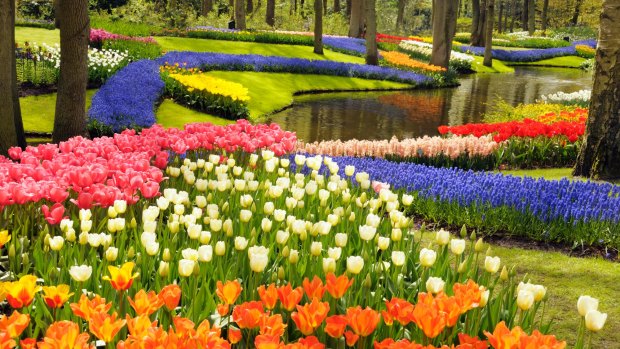
Tulips bursting into life at Keukenhof Gardens, half an hour from Amsterdam. Credit: iStock
Perhaps more than any other European nation, the Netherlands is a place of iconic, tangible cliche: windmills, clogs, tolerance of narcotics and prostitution, canals, life at or below sea level, herring sandwiches, superior cheese, avid cyclists… You can see all of those things within a couple of hours of landing in Amsterdam, but, historically at least, nothing is quite as popular as the beloved tulip.
How and why the flower came be so inextricably linked with a nation in which it is not native is at the heart of Deborah Moggach's book Tulip Fever, which will this year be turned into a Hollywood film. Starring Dane DeHaan and Alicia Vikander as two-star crossed lovers, their affair takes place in 1630s, during the height of the tulip boom. Director Justin Chadwick will have had to add little in the way of special effects to recreate the city as it was in the 17th century, so well preserved is its gorgeous centre.
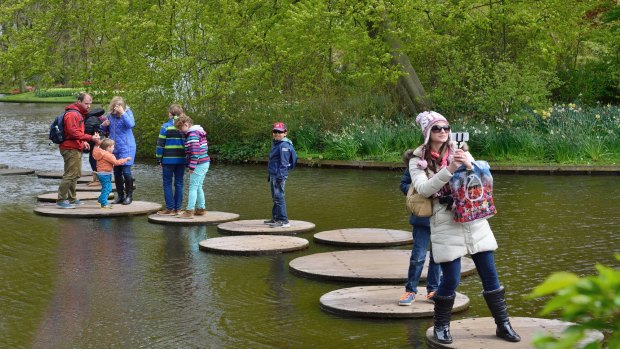
Negotiating the lily pad walkway over a pond at Keukenhof Gardens.Credit: iStock
"Fashionable men and women stroll along its streets and the canals mirror back the handsome houses in which they live," wrote Moggach to describe the Amsterdam of her novel, but also the city of today. "The city is threaded with mirrors. They reflect the cold spring sunshine. Copper-coloured clouds lie motionless beneath the bridges. The city sees itself in its own water like a woman gazing into a looking-glass."
In spring, tulips fill boxes outside of bars and restaurants, their intense petals turned towards the sun alongside the faces of the surrounding residents emerging after a deep winter. On street-level in Amsterdam you can see tulips everywhere, but the natural destination for anyone with a love of the flowers is the enormous Keukenhof estate, half an hour to the west.
Over 7 million flowers are planted there every year, yet even before getting there, fields appear as though God has spilt paint. Tulips bloom, but so too do daffodils, hyacinth and roses.
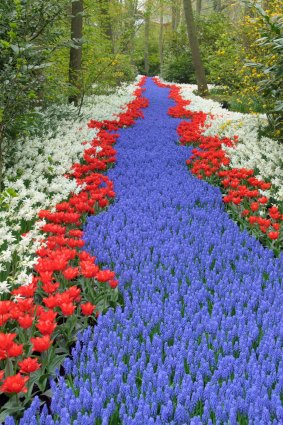
A river of grape hyacinths, tulips and daffodils.Credit: iStock
Inside Keukenhof, visitors quickly learn that the classic idea of a tulip as a bright red wine-glass is no more representative than an Alsatian is of all dogs. If some of the tulips look unnatural, that's because they are. Centuries of selective cultivation have emphasised some pretty freaky characteristics. Some look dainty, others durable; one frayed, another fabulous. The Paris Sweets look like ersatz lettuce. The hue of orange in Okura appears oversaturated, as though carrying too much data for the human eye. The Wonder Clubs look like several flowers stuck together, none of which are tulips.
This year 1.4 million people arrived from over 100 countries to see the flowers inside Keukenhof. They ranged from bored children to avid horticulturalists, but it's unlikely there would have been many traders, the likes of which are featured in Tulip Fever. Instead, they would have been indulging their floral fixation on the outskirts of Amsterdam.
Stripped of the romance of the city's golden age, the Aalsmeer Flower Auction is the largest in the world, a vast, frenetic place covering 518,000 square metres close to Schiphol International Airport. There's no haggling in taverns and talking up the beauty of individual bulbs, but a sprawling computerised system in which science has replaced impulse, order where once there was blooming chaos. The Netherlands can't naturally support the planet's year-round need for flowers – the 20 million or so that are bought and sold here every day are grown in Africa and South America, then sold across the planet. Flowers that will make up funerary wreaths, single roses to woo a lover, the last-minute panic-bought bouquet on the Mother's Day morning – whether your heart is soaring or breaking, there are literally tonnes of flowers here for every occasion.
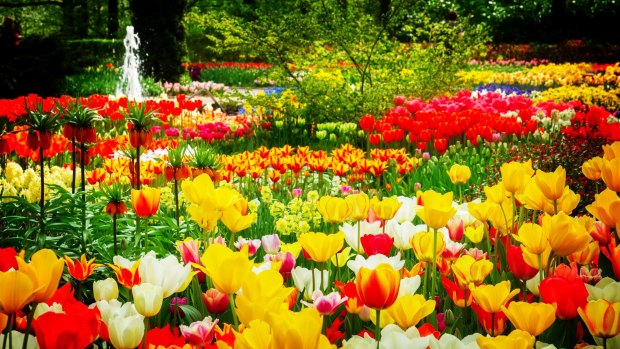
White, red, yellow tulips.Credit: neirfy
With annual sales counted in billions, Aalsmeer is known as the "Wall Street of Flowers". But when the country was gripped by tulip fever, the bulbs were to traders as sub-prime mortgages were to financiers in the early part of this century. Of course, it couldn't end well for the tulip traders. "We have long ago lost sight of the bulbs; they have become an abstraction," says Moggach's doomed protagonist. "We are buying bulbs we have never seen and for which we have not yet paid, gambling on new varieties, that their price will rocket, trading onwards and upwards."
TRIP NOTES
MORE
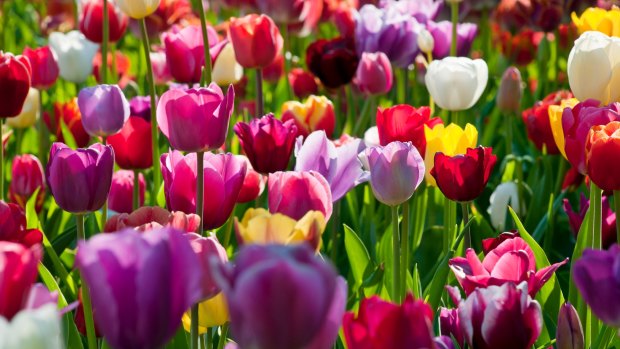
Tulips by the million bloom in the Keukenhof garden, Netherlands.Credit: iStock
VISIT
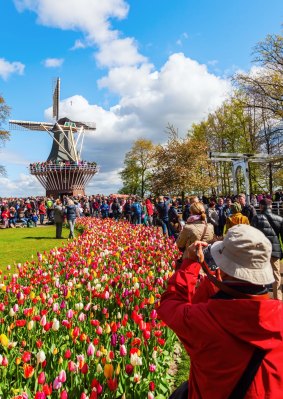
A windmill at Keukenhof park.Credit: iStock
Keukenhof is only open in spring; the spectacle is usually at its grandest by mid-April. See keukenhof.nl.
FLY
Etihad, Emirates and Qatar all offer flights to Amsterdam via their hubs in the Gulf from Melbourne and Sydney. See etihad.com; emirates.com; qatarairways.com.
STAY
In the very centre of old Amsterdam, the Hotel De L'Europe has one of the best locations anywhere on the continent and it offers a dedicated tulip package, see deleurope.com.
Jamie Lafferty travelled as a guest of Hotel De L'Europe.
Sign up for the Traveller Deals newsletter
Get exclusive travel deals delivered straight to your inbox. Sign up now.